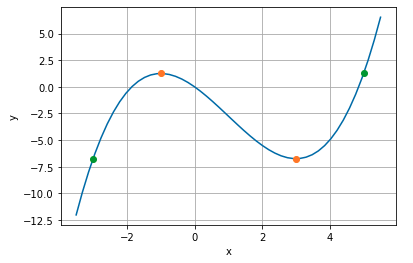36 Problem set 6 solutions
Q1. A van der Pol equation
- Determine \(f(x)\) so that this equation can be written as a Liénard phase plane system in the form \[ \begin{aligned} \epsilon \dot{x} &= f(x) + 4y, \\ \dot{y} &= -x. \end{aligned} \]
- For fixed \(\epsilon > 0\), find the equilibrium point(s) in the phase plane, find their eigenvalues, and classify their linear stability.
- Use the expansions \(x(t) = x_0(t) + \epsilon x_1(t) + O(\epsilon^2)\) to determine the equations for the leading-order slow solution. Sketch the slow manifold, indicate the directions motion on each part, and identify the two attracting points on the curve.
- Use the expansions \(x(t) = X_0(T) + \epsilon X_1(T) + O(\epsilon^2)\) and \(y(t) = Y_0(T) + \epsilon Y_1(T) + O(\epsilon^2)\) with \(T = t/\epsilon\) to obtain the leading-order fast solution.
- Use the phase plane to determine the maximum and minimum values of \(x(t)\) during an oscillation. Sketch \(x(t)\) as a function of time.
Q2. Fast-slow dynamics with three variables
- For the system \[ \begin{aligned}[c] \dot{x} &= 2 - y, \\ \dot{y} &= x-z, \\ \epsilon\dot{z} &= y - y^2 + \frac{1}{3}y^3 - z, \end{aligned} \] with the initial conditions of \(x(0) = 1\), \(y(0) = 3\), and \(z(0) = 0\).
Identify the surface \(z = S(x, y)\) that defines the slow manifold. Find the equilibrium point of the leading=order slow phase plane system and show that it is asymptotically stable for \(t \to \infty\). Also determine the form of the initial layer that describes the transition from the initial conditions to the slow manifold.
- For the system \[ \begin{aligned}[c] \dot{x} &= 2 - y, \\ \epsilon\dot{y} &= x-z, \\ \dot{z} &= y - y^2 + \frac{1}{3}y^3 - z, \end{aligned} \] with the initial conditions of \(x(0) = 0\), \(y(0) = 3\), and \(z(0) = 1\).
Show that the slow manifold reduces to a curve that could be written in parametric form as \(x = x(z), y = y(z), z = z\). Determine the asymptotic solution for \(t \to \infty\). Also determine the form of the initial layer that describes the transition from initial conditions to the slow manifold.

